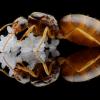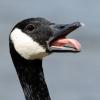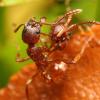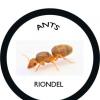Wow, seems like I started a bit of a debate here.
From what I can tell online, it seems like my idea of a terrarium nest would equate to what this community would call a "natural nest."
Size/Container: I'm not thinking anywhere NEAR a 75 gallon tank! Here are some pictures of the glass enclosure I'm planning to use...
https://photos.app.g...z7tmHrC76wykho9
The whole container is actually quite small, really only 2-3 gallons in size. It's got six sides, each side measures about 4" across. The bottom is 6" across corner to corner/side to side. The primary digging/nesting space would take up about 60 cubic inches, comprised of native soil, native mulch (probably pine) and untreated wood plank (4x1 cut into 4" lengths). I actually purchased the wood plank today - I'm going to soak it for about 24 hours, and then bury it under my compost pile sandwiched between some heavy cinderblocks. I'll leave it there for a while so it can begin to break down a little bit and help establish a healthy system of microorganisms inside the terrarium. I also think that softened/wood beginning to rot will be easier for the ants to begin digging into.
I know it will take time for the colony to grow into the space. When you're using plastic/AAC/plaster/etc formicariums, you'd certainly need to add as they need it, because they can't add on their own. I feel like, if I'm placing them in a natural nest, they'll add as they need it all by themselves. At least, until they've taken up the whole space, at which point I could build a larger, new natural nest terrarium, and dry out the old terrarium forcing them to move. The container does have a port on one side, which I will plug up. I could eventually connect some tubing here, and lead that to another tank/nest/formicarium.
The container is entirely glass, no silicone or anything to it. I would probably put fluon/insect-a-slip around the inwardly sloped top area, and could also rubber band some window screen/fine mesh over the top for added protection.
Watering: Terrariums have a drainage layer at the bottom, usually large rocks. I like to use mountain granite landscaping rock in mine. Water would collect there. Enclosed terrariums have a water cycle, where water condenses on the top/sides, falls and waters the ground, seeps to the bottom, and repeat. Since my natural nest would have an opened top, and be somewhat dry to begin with, I'd probably need to add water once a month or so, and not very much. Most of the moisture would be trapped in the drainage layer. I don't feel like drowning the nest would ever be a concern, but I could always route a tube to the drainage layer so I could add water directly into the drainage layer, bypassing the soil/substrate entirely.
Feeding: I've seen people place insects in on things like sticks/skewers, but I've also seen people placing food in on a small dish or piece of tin foil. I'd probably go the tin foil route, and make a little basket to lower down on a string with a paperclip. That would make it easy to remove if it seems they're not interested. I would expect the natural ecosystem of the terrarium to take care of breaking down their natural waste, at least until the colony got too large/the waste got to be too much.
Ants: Yes, I do know the colony needs a queen.  I promise I've been paying attention in class! There's a thriving camponotus colony in a stump in my back yard, as I stated in my initial post. I can usually see 25-35 workers (about 5-7 per entrance, with about 5-6 entrances built up) on the surface, so I'm sure there are MANY more underground! I have been keeping a very close eye on them, as it is their season for mating flights in my area. I captured a few workers last night to observe and measure, and went through the listings on AntWeb for my area. I'm pretty sure they're Camponotus Modoc from the pictures on AntWeb, and also from viewing videos of Camponotus Modoc on YouTube.
I promise I've been paying attention in class! There's a thriving camponotus colony in a stump in my back yard, as I stated in my initial post. I can usually see 25-35 workers (about 5-7 per entrance, with about 5-6 entrances built up) on the surface, so I'm sure there are MANY more underground! I have been keeping a very close eye on them, as it is their season for mating flights in my area. I captured a few workers last night to observe and measure, and went through the listings on AntWeb for my area. I'm pretty sure they're Camponotus Modoc from the pictures on AntWeb, and also from viewing videos of Camponotus Modoc on YouTube.
I've already ordered some test tubes on Amazon, because I DO definitely agree that getting the queen started with her first set of workers is vital before moving them into the space. Letting her get her stuff together also gives me time to build the terrarium, plant in it, and let it go through it's own cycles of growing and getting stable. So, I'm hoping to catch a few queens from the colony out back, and keep them in test tubes for the first year or so. I got BIG glass test tubes, because I read on a different forum that C. Modoc prefers glass and some extra space... Then, I'd follow the AntsAustralia method of laying their test tube down in the Terraricarum and letting them pick their new home.
Remaining Concerns:
Filter Layer - Usually I would add a "filter" layer of activated carbon between the rocks and soil in my terrariums. Construction normally goes: rocky drainage, screen, charcoal, soil, plants. BUT, I usually don't have something digging around in my terrariums! The carbon layer needs to stay in place, so water can drain down through it and absorb the toxins. You don't want it all mixed up with the soil. But, there's a chance the ants could mix it up with the soil, if they dig that far down. I'm thinking of using an additional layer or two of fiberglass window screen. I'm still wondering if that would be enough, or if curious workers might still feel driven to chew holes through the mesh and start moving the activated carbon around. Would it be best to order some kind of special meshing, and maybe make an activated carbon "pillow" to place between the rocky layer and the soil layer? 
Temperature control - I should almost definitely add some kind of temperature control to this setup. Possibly a heat cable routed through some clear tubing? This might be a good use of the port on the front of the container. Or maybe I could velcro a small reptile heat mat to one of the sides? I've not quite worked this out yet, and I've not seen a lot of detailed information on temperature control for nests, although it seems like it's very important for getting the nest just right.
Plant Choice - Whatever I choose to plant on the "upper level", it has to be limited to 4-6" in overall height, or I'm going to have to prune it constantly. I'm thinking rock cress, lobelia, violas, johnny jump ups or aubrieta. But, I'm open to suggestions! The "lower level" would have very (VERY) shallow, clay heavy substrate, and I would likely plant moss and maybe some clover on this level.
Okay, that's everything I can think of for now!
![]() They have a great stump away from human traffic, though, so I doubt that's going to happen.
They have a great stump away from human traffic, though, so I doubt that's going to happen.



























